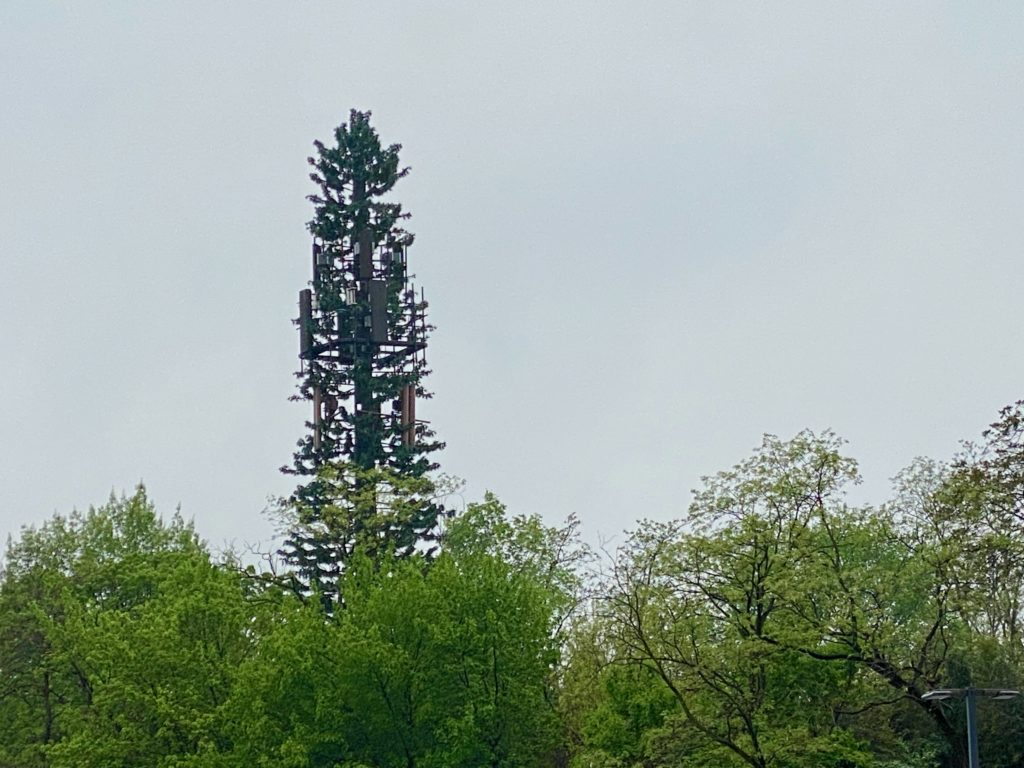Summary
I was in Saint Louis last week, and noticed that my iPhone 11 Pro Max displayed 5GE in the top right corner — next to the cellular signal strength bars. That prompted me to write up this guide for those concerned about the health impact of 5G cellular service.
Balanced Perspective
There are conflicting views about 5G safety. Device vendors and service providers want everyone to feel 100% safe with the technology. Others, including the FAA, warn of 5G safety concerns. This document offers some balanced perspective on this topic.
5GE is not 5G
Those concerned about the health risks of 5G can be reassured knowing that 5GE is something different. AT&T has been criticized for using the 5GE name to describe their improved 4G LTE service. The 5GE service is not the same as 5G. It is a faster version of the existing technology.
According to an article in PC World, “AT&T’s 5GE network is merely a slightly faster LTE network. You’re still connecting to the same network as before, but through a combination of 4×4 MIMO and 256 QAM, some phones might see faster speeds in some areas. It’s basically marketing lingo.” [Source]
While in Saint Louis, near the Laumeier Sculpture Park, I was able to get speeds of about 283 Mbps download and 60 Mbps upload. Other areas of the city had slower 5GE service. So, while 5GE isn’t true 5G service, the performance is quite good.
Poor Naming for Industry Standards
The term “5G” can have several different meanings:
- Fifth Generation — The 5G name conveys a newer standard of cell phone service as an evolution from 2G to 3G, then 4G, and now 5G.
- Five Gigahertz — Some home WiFi routers will have 5GHz and 2.4GHz frequencies available. Some people may refer to the 5GHz frequency as “5G” which is incorrect.
- Improved 4G — As mentioned above, AT&T uses the term 5GE to represent an improved version of existing 4G LTE service.
These different uses of the 5G naming create confusion among consumers.
Some Concern is Warranted
In general, regarding exposure to radio frequency emissions, some concern is warranted, but any adverse health impacts will be determined based on length of time, distance, equipment condition, power intensity, and other factors. Infrequent exposure from a long distance is less risky than frequent exposure at a close distance. Exposure to low intensity radio waves is less harmful than exposure to high intensity radio waves. So, as with other things in life, it depends on the circumstances.
Brain Tumor
In the 1990s, as mobile phones became more commonly used, I knew of someone who became an enthusiastic cell phone user. His work involved being on the phone all day. He told me that the phone would get hot next to his head, and his head would tingle.
I warned him to be careful to keep the phone at a distance and limit time spent using the phone. I recommended using the speakerphone feature or a headset.
About a year later, he called to tell me that he had developed a brain tumor on the side of his head where he would usually hold the phone. The surgery to remove the tumor resulted in a loss of hearing in that side of his head.
So, as we might expect, a poorly designed phone, used for many hours a day, close to the head, in a rural area at high output power, could potentially result in harm.
Poor Installation of Defective Equipment
In addition to harm caused by a personal device, there are potential dangers from service provider systems. The worst case scenario would be poorly installed defective equipment. Imagine you live in an apartment in the city. Outside your apartment window is a telephone pole. One day, you notice an antenna has been installed. The antenna is mistakenly installed to direct the radio signals into the building rather than toward the street. The signal is directed through your window toward your bed. The installer forgot to put protective shielding on the antenna that would normally block intense radio signals from humans nearby. In addition to these problems, the antenna design and manufacturing was faulty so the unit produces higher than approved levels of radio waves.
In this scenario, a person sleeping next to the antenna would have excessive exposure to the radio waves which could be harmful.
Factors Impacting Cell Phone Safety
I’ve known plenty of cell phone users who have not developed brain tumors. Here are some factors that determine how safe a cell phone might be.
DIRECTIONAL SIGNAL — Some antennas used to transmit or receive radio signals will transmit or receive from many directions evenly. On old cars, an FM radio antenna would be a flexible piece of metal sticking straight up. This allowed for adequate reception regardless of where the signal was coming from. With CB (citizen’a band) radio antennas, a common design is to have a tall vertical antenna that transmits and receives from all directions. However, with some antennas, like a TV antenna on the roof of a home, there are multiple parallel metal rods aligned and pointed in a certain direction. This amplifies the receiving efficiency for a certain direction. This type of antenna can also provide a directional transmission. A microwave antenna dish is another way to amplify and direct a signal. Modern home routers have a feature called “beamforming” which will attempt to create directional output and reception. [Learn More] This reduces radio waves where they are less needed and increases them where they are needed. Such efficiencies could help devices operate at lower output levels making them safer. In other words, interacting with an efficient receiver / transmitter reduces demands on the portable or WiFi device. If you are in the direction of a magnified focused beam of intense radio waves, there could be a health hazard. Think of how sunlight when focused through a magnifying glass has great concentrated heat capable of starting a fire. A laser beam is a method of directing intense waves of light. With enough power, a laser can cut through metal.
EQUIPMENT DESIGN — Early computers and components were designed with metal shielding to reduced RF (radio frequency) emissions. This was to prevent interference with other devices, and also reduce health risks from exposure. Any device designed to emit radio frequencies, like a cell phone, should be properly shielded and have a properly designed antenna. Consumer safety testing of early cell phones revealed that some were safer than others. Poor shielding and improper output could result in adverse health effects.
SIGNAL OUTPUT POWER — Cell phones and radio transceivers have the ability to increase their output when needed. If a mobile phone is far away from a cell tower, it might boost the output to ensure a good connection to the distant tower. The maximum output is limited for safety — an acknowledgement from the industry that radio frequencies can be potentially hazardous. The limiting of output is also intended to prevent interference with other devices in the same area. Someone using a cell phone in a rural area far away from a cell tower might notice their phone getting hot, and the battery may diminish quickly. This is because of the additional power needed to reach the cell tower. So, a person living far from a cell tower may be more at risk in such a scenario. Being closer to a cell tower could be safer if it results in your phone using output power. The safest option would be to not use a cell phone at all, and live in a remote area of Montana where there are no cell phone towers.
USER DISTANCE — Early cell phones (called bag phones) had corded handsets. The person using the phone would not be near the antenna. So, that distance significantly diminished their exposure to the transceiver output. People using corded headphones or the speakerphone feature of a smartphone can reduce their exposure to radio waves emitted. Consider this example, at a dental appointment, you might be draped with a lead apron during the x-ray process, but the dental hygienist will simply step out of the room, perhaps behind a wall. This is because distance from a radiation (or radio transmission) source dramatically reduces the exposure. As explained by the NIH: “The amount of radiation exposure is not inversely proportional to the distance from the radiation source, but is inversely proportional to the square of the distance. This means that double the distance from the radiation source can reduce the radiation exposure not to 1/2 but to 1/4. Therefore, maintaining a greater distance from the X-ray generator is a very effective method for radiation safety.” [Source: “Three principles for radiation safety: time, distance, and shielding” Read ]
Radio Waves are Everywhere
We can’t completely escape 5G cellular emissions, or any other radio signals. Cell towers are all around us. Even if you don’t use a cell phone and don’t have a microwave oven, your body is being bombarded by radio waves.
The photo below was taken near Forest Park in Saint Louis. On the left we see what looks like a pine tree sticking up above the other trees. That’s not a pine tree. It’s a cell phone tower designed to look like a tree.

Below is a zoomed in view of that same pine tree. You can see the antennas scattered around the fake tree.

To learn more about cell towers designed to look like trees read, “The bizarre history of cellphone towers disguised as trees.” [Source: Vox, 19 Apr 2015]
Conclusion
It is good to limit one’s exposure to all kinds of things: breathing any kind of smoke, loud noises, listening to music at high volume, looking at lasers, etc. Usually we consider the duration and intensity of exposure to potentially harmful conditions. It’s important not to live in a state of debilitating fear. We need to weigh the risks of all things we’re exposed to.
Putting things in perspective is important. There are many things potentially more dangerous than 5G cellular emissions. An example would be solar storms that send high power damaging energy blasts toward earth that can disable electronics across entire continents. These energy blasts go through your body as well. This is described in the video below. [Source: “It Missed Us by 9 Days” by Dianna Cowern, 18 Apr 2022]
